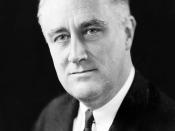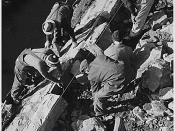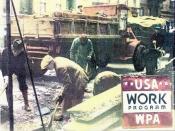During the time period of 1933 through 1938, Franklin Delano Roosevelt sought to wage war on the Great Depression. He waged this war through programs aimed at three different goals-relief, recovery and reform. Via these three R's, Roosevelt targeted many aspects of the economy from banks to the living conditions of the people. He helped the American people regain faith in themselves while at the same time bringing hope as he promised prompt and vigorous action while asserting in his Inaugural Address that "the only thing we have to fear is fear itself." As a result of FDR's efforts and with a shift of the government in the people's lives from being passive to active, America was able to walk on more stable ground, even with a few stumbles here and there.
As FDR was inaugurated, he wasted no time getting to work on the New Deal. The New Deal included federal action of extraordinary range to fuel the recovery of the industry, assist victims of the Depression, guarantee minimum living and working standards and prevent these types of economic crises from happening again in the future.
After the Stock Market Crash of 1929, as depicted in Doc J, the number of unemployed nonfarm workers skyrocketed. Along with statistics such as a 25% unemployment rate, 22% of banks failing, 55% decrease in farming, worker incomes down 41% and the value of goods being produced in the economy down almost a half also made it clear that immediate action was necessary. FDR answered such a call and within his first "hundred days" he proposed to Congress the New Deal program to bring relief to the unemployed and to those in danger of losing their farms and homes, recovery to businesses and agriculture, and reform to catastrophes and current abuses of that...


